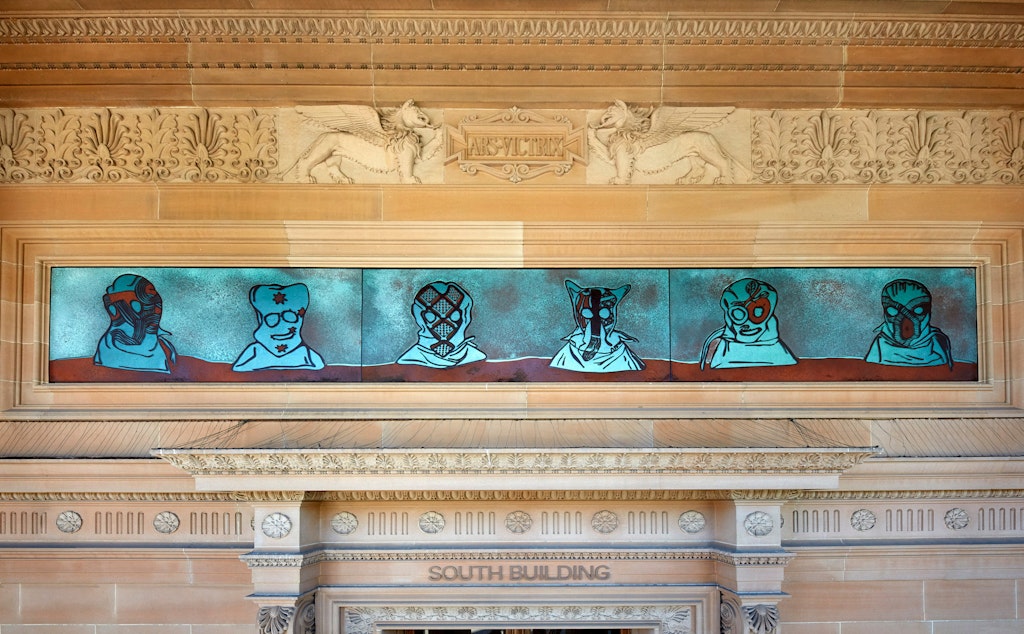Karla Dickens

Installation view of Karla Dickens To see or not to see 2022, Art Gallery of New South Wales © Karla Dickens
To see or not to see 2022
The work of cross-cultural Wiradjuri woman Karla Dickens is an unflinching interrogation of post-contact Aboriginal experiences and the continuing legacies of colonialism and patriarchy. Depicting hooded figures, To see or not to see is a panel made of glass and various metals, installed above the doorway of the Art Gallery of New South Wales’ historic South Building.
Dickens has used materials that nod to the nearby bronze panels on the building, to the rusty metal of Sydney humpy towns – once home to so many First Nations people, including Dickens’ grandmother – and to the clear blue-green of the harbour’s life-sustaining waters.
The imagery derives from hoods she first made from raw calico, and from vintage tea towels of the type her grandmother might have used. In Dickens’ hands, the hoods become potent symbols of the violent silencing and enforced control that are part of the legacy left to Aboriginal women today.
From her home in Bundjalung Country (Lismore, NSW), Dickens works towards healing and change through truth-telling. She reminds us that, under the cover of these hoods, ‘the hooded are still bearing witness’.
-
K–6 discussion questions
Look closely and describe this artwork. Can you see any eyes or mouths underneath the hoods on these figures? Why do you think the artist has not included any faces? Discuss the artwork’s title. How do you feel when you can’t see?
‘There are Masks and there are Hoods’, writes the artist in a poem she composed about this work. What do you think she means by this? Who have you seen wear a hood or a mask? Discuss the difference between the two and consider their purpose and symbolism.
-
K–6 activities
To see or not to see is on the facade, or front, of the Art Gallery’s historic sandstone building. Design an artwork to occupy a position on the front of your house. Select materials that are important to you. What ideas will you communicate? Sketch your idea and explain the significance of your facade artwork to your class.
-
7–12 discussion questions
Consider Dickens’ use of materials, the ‘rusty metal of Sydney humpy towns and the clear blue-green glass of its once-abundant harbour’. Discuss the ideas they bring to her work and how they relate to the sandstone and bronze of the Art Gallery’s neoclassical facade.
To see or not to see fills the niche above the entrance of the Art Gallery that had been left empty since the building’s construction. Consider this history and the context in which the work now sits – the architecture, its central position and the neighbouring friezes. How might Dickens’ work be interpreted in relation to its site? Discuss the significance of its location above the doorway.
-
7–12 activities
Think about how items worn on the body can powerfully evoke physical and emotional experience. Using found fabrics or papier-mâché, design and create a wearable item that communicates such a feeling. Consider the symbolism and physical experiences related to different parts of the body.
Research Dickens’ art practice and her use of the hood motif to explore issues of race, gender, violence and injustice. Discuss how hoods may suggest enforced invisibility. Study hoods Dickens has made from vintage tea towels and discuss their symbolic meaning. How is the comforting familiarity of these materials made unsettling?